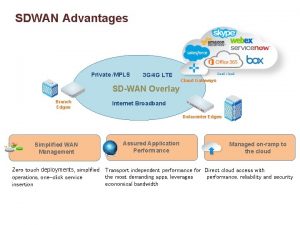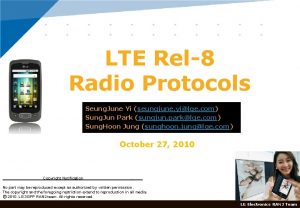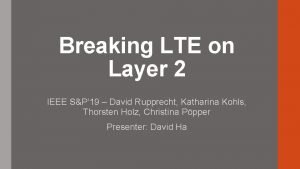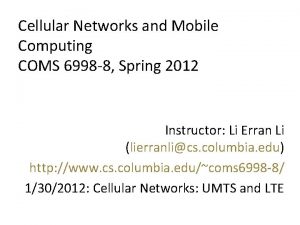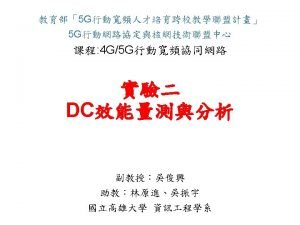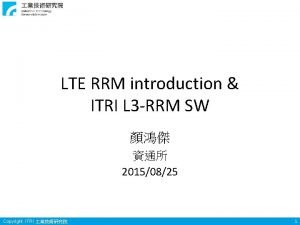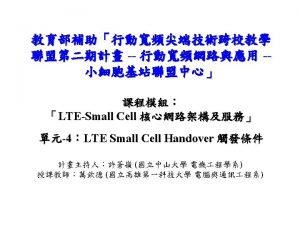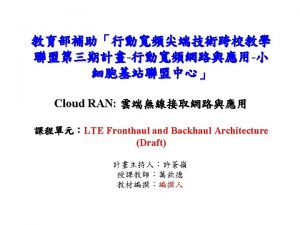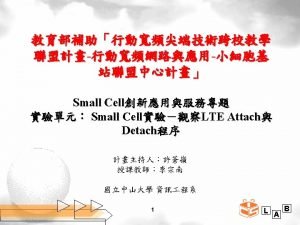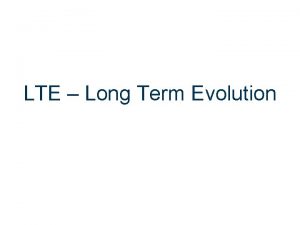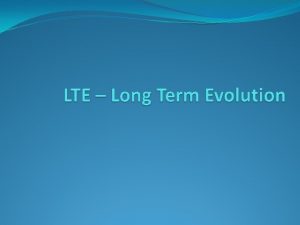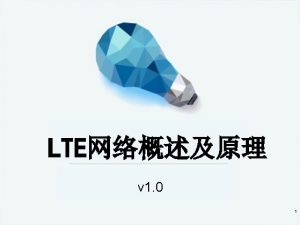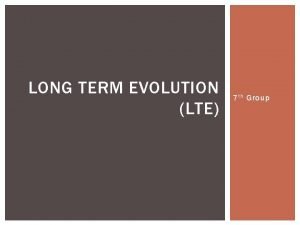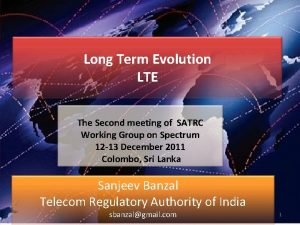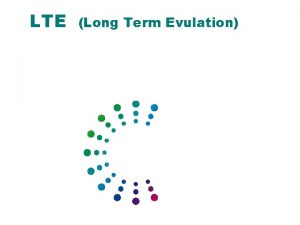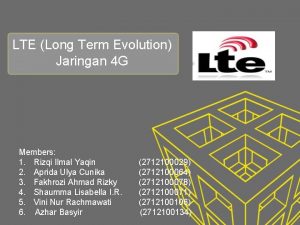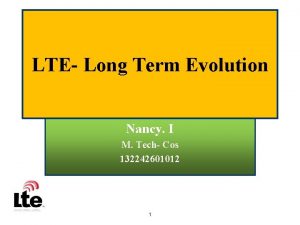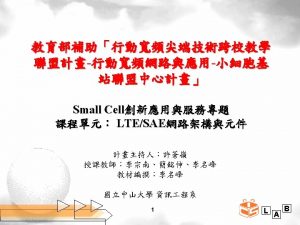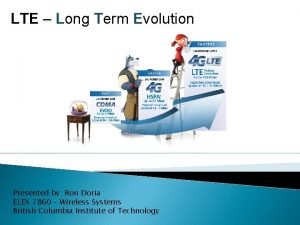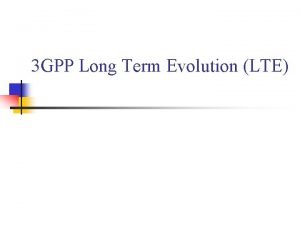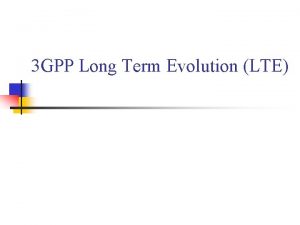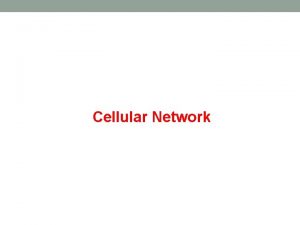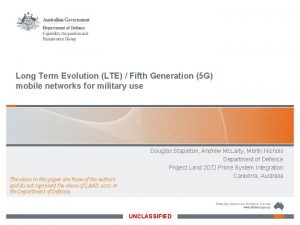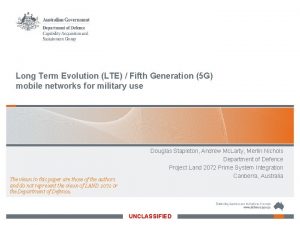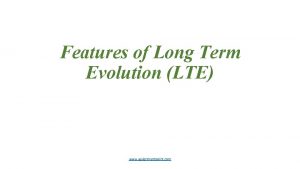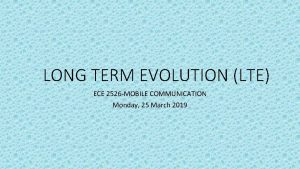Long Term Evolution LTE 2 Long Term Evolution






















- Slides: 22

Long Term Evolution (LTE)

2 Long Term Evolution (LTE) • Long-Term Evolution (LTE) is a standard for high-speed wireless communication for mobile devices and data terminals, based on the GSM/EDGE and UMTS/HSPA (High Speed Packet Access) technologies. • GSM (Global System for Mobile communication) • EDGE (Enhanced Data rates for GSM Evolution) • UMTS (Universal Mobile Telecommunications Service) • HSPA (High Speed Packet Access) • WCDMA (Wideband CDMA) • GPRS (General Packet Radio Services) • HSCSD (High-Speed Circuit-Switched Data)

3 Cellular Network Generations: Ø 1 G: ü Analog cellular telephony. Ø 2 G: ü Digital cellular telephony. Ø 3 G: ü High-speed digital cellular telephony (including video telephony). Ø 4 G: ü IP-based voice, data, and multimedia telephony (at faster data rates than 3 G).

4 The Source of “G”:

5 Evolution of Mobile Communications: From 1 G to 4 G

6 The Multiple Access Problem: Ø FDMA: Ø TDMA: Data Signal Ø CDMA: PN Sequence Tx Signal

7 Evolution of Mobile Communications: From 2 G to 3 G

GSM Evolution: From 2 G to 3 G Dedicate up to 4 timeslots for data connection ~ 50 kbps Good for real-time applications (but inefficient) HSCSD GSM 9. 6 kbps (one timeslot) GSM GPRS Enhanced Data Rates for Global Evolution 3 x improvement in data rate ~ 384 kbps Can fall back to GMSK for greater distances General Packet Radio Services Data rates up to ~ 115 kbps Max: 8 timeslots used as any one time Packet switched (Efficient, but variable delays) 8 WCDMA EDGE

9 Evolution of Mobile Communications: From 1 G to 4 G

10 Outlines: Ø Motivation Ø LTE Performance Requirements Ø Key Features of LTE Ø OFDM & SC-FDMA Ø LTE Network Architecture Ø Multiple Antenna Techniques Ø LTE-A Specifications Ø Summary

11 Motivation: ØNeed for higher data rates and greater spectral efficiency: Ø Can be achieved with HSDPA/HSUPA ((High Speed Packet Access) Ø and/or new air interface defined by 3 GPP (3 rd Generation Partnership Project) LTE ØNeed for Packet Switched optimized system: Ø Evolve UMTS towards packet only system ØNeed for high quality of services: Ø Use of licensed frequencies to guarantee quality of services Ø Reduce control plane latency & round trip delay ØNeed for cheaper infrastructure: Ø Simplify architecture (reduce number of network elements)

12 LTE Performance Requirements: ØData Rate: Ø Downlink peak data rate of 100 Mbit/s in a 20 MHz downlink spectrum. Ø Uplink peak data rate of 50 Mbit/s in a 20 MHz uplink spectrum. ØMobility: Ø Optimized for low mobility (0 -15 km/h) but supports high speed. ØLatency: Ø user plane < 5 ms Ø control plane < 50 ms Ø The control plane is the part of a network that carries signaling traffic and is responsible for routing.

13 LTE Performance Requirements: ØImproved spectrum efficiency. ØImproved broadcasting. ØIP-optimized. ØScalable bandwidth: Ø 20 MHz, 15 MHz, 10 MHz, 5 MHz and <5 MHz ØCo-existence with legacy standards: Ø Users can transparently start a call or transfer of data in an area using an LTE standard, and when there is no coverage, continue the operation using GSM/GPRS or W-CDMA-based UMTS.

14 LTE Key Features: ØMultiple access scheme: Ø Downlink: OFDMA (Orthogonal frequency-division multiple access) Ø Uplink: SC-FDMA (Single-carrier FDMA) Ø Adaptive modulation: Ø DL modulations: QPSK, 16 QAM, and 64 QAM Ø UL modulations: QPSK and 16 QAM ØBandwidth scalability: Ø For efficient operation in differently sized allocated spectrum bands. ØMultiple Antenna (MIMO) technology: Ø For enhanced data rate and performance. ØPower control and link adaptation. ØImplicit support for interference coordination.

15 OFDMA:

16 OFDMA & SC-FDMA (for QPSK symbols):

17 Adaptive Modulation:

Packet Data Network (PDN) LTE-A Network Architecture: e. NBs (evolved Node. Bs) as base stations 18 Evolved Packet Core (EPC) Policy and Charging Rules Function (PCRF) Mobility Management Entity (MME) Packet Data Network (PDN) E-UTRA is the air interface of 3 rd Generation Partnership Project (3 GPP) Long Term Evolution (LTE)

19 MIMO:

20 Comparison of 3 G & LTE-A Specifications:

21 LTE-A Specifications:

22 Summary: ØLTE-A is a highly optimized, spectrally efficient, mobile OFDMA solution built from the ground up for mobility. ØIt allows operators to offer advanced services and higher performance for new and wider bandwidths. ØIt is based on a flattened IP-based network architecture that improves network latency. ØIt is compatible with existing 3 GPP networks. ØIt leverages the benefits of existing 3 G technologies and enhances them further with additional antenna techniques (such as higher-order MIMO).
 Ofdm
Ofdm Short term human resources
Short term human resources Short term financial management
Short term financial management Difference between long term and short term liabilities
Difference between long term and short term liabilities Long medium and short term planning in primary schools
Long medium and short term planning in primary schools Long-term liabilities examples
Long-term liabilities examples Long term memory vs short term memory
Long term memory vs short term memory Short term goal
Short term goal Tall+short h
Tall+short h Once upon a time there was a fox
Once upon a time there was a fox Gpp lte meaning
Gpp lte meaning Mpls advantages and disadvantages
Mpls advantages and disadvantages V0 lte
V0 lte Lte nas procedures
Lte nas procedures Breaking lte on layer two
Breaking lte on layer two Frame structure in lte
Frame structure in lte Dtch lte
Dtch lte V lte symbol on phone
V lte symbol on phone L
L Mobility mode
Mobility mode Lte vo
Lte vo Fronthaul and backhaul transport
Fronthaul and backhaul transport Attach procedure
Attach procedure











